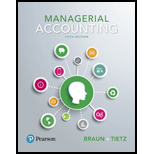
Concept explainers
Explain why companies use zero-based budgeting (Learning Objective 1)
Unilever is a multinational consumer goods company headquartered in Rotterdam, Netherlands, and London, United Kingdom. Some of its major brands in the United States include Dove, Heilman’s, Lipton, and Ben & Jerry’s. The company is organized into four main divisions: Foods, Refreshment (beverages and ice cream), Home Care, and Personal Care.
Despite reporting better than expected results for 2015, the Unilever CEO, Paul Polman, warned that the company expected tougher market conditions in 2016. Speaking in mid-January 2016, Polman pointed to the volatility in the stock market in January 2016 as evidence of the tougher market conditions.
Polman stated that Unilever would be rolling out a zero-based budgeting initiative across the entire company. This initiative was expected to save approximately €1 billion (about $1.09 billion in US dollars) per year by 2018. Unilever was seeking steady improvement in its gross profit.
Requirements
- 1. What is zero-based budgeting?
- 2. What is gross profit?
- 3. How would zero-based budgeting help Unilever increase its gross profit?
- 4. How would zero-based budgeting impact Unilever’s
cash flows ? - 5. What benefits does zero-based budgeting potentially hold for Unilever? What disadvantages?
- 6. Put yourself in the position of a brand manager for Unilever. Imagine that your brand has been performing well over the past three years. How would you feel about the zero-based budgeting initiative? How could this impact your work performance?
Want to see the full answer?
Check out a sample textbook solution
Chapter 9 Solutions
Managerial Accounting, Student Value Edition (5th Edition)
- In 2011, It cost Parley Corp. $9 per unit to produce part T5. In 2012, it has increased to $12 per unit. In 2012, Southside Company has offered to provide Part T5 for $7 per unit to Westa. As it pertains to the make-or-buy decision, which statement is true?arrow_forwardWhat is its ROEarrow_forwardKendall Corporation uses the weighted-average method in its process costing system. The ending work in process inventory consists of 10,000 units. The ending work in process inventory is 100% complete with respect to materials and 60% complete with respect to labor and overhead. If the cost per equivalent unit for the period is $4.00 for materials and $1.50 for labor and overhead, what is the balance of the ending work in process inventory account?arrow_forward
- A manufacturer sells a product for $45 to a wholesaler, and the wholesaler sells it to a retailer. The wholesaler's normal markup (based on selling price) is 25%. The retailer prices the item to consumers to include a 33% markup (also based on selling price). What is the selling price to the consumer?arrow_forwardFinancial Accountingarrow_forwardWhat is the price per share of Stanton corp. according to the comparable multiples approach for this financial accounting question?arrow_forward
 Managerial AccountingAccountingISBN:9781337912020Author:Carl Warren, Ph.d. Cma William B. TaylerPublisher:South-Western College Pub
Managerial AccountingAccountingISBN:9781337912020Author:Carl Warren, Ph.d. Cma William B. TaylerPublisher:South-Western College Pub Managerial Accounting: The Cornerstone of Busines...AccountingISBN:9781337115773Author:Maryanne M. Mowen, Don R. Hansen, Dan L. HeitgerPublisher:Cengage Learning
Managerial Accounting: The Cornerstone of Busines...AccountingISBN:9781337115773Author:Maryanne M. Mowen, Don R. Hansen, Dan L. HeitgerPublisher:Cengage Learning Financial And Managerial AccountingAccountingISBN:9781337902663Author:WARREN, Carl S.Publisher:Cengage Learning,
Financial And Managerial AccountingAccountingISBN:9781337902663Author:WARREN, Carl S.Publisher:Cengage Learning,


